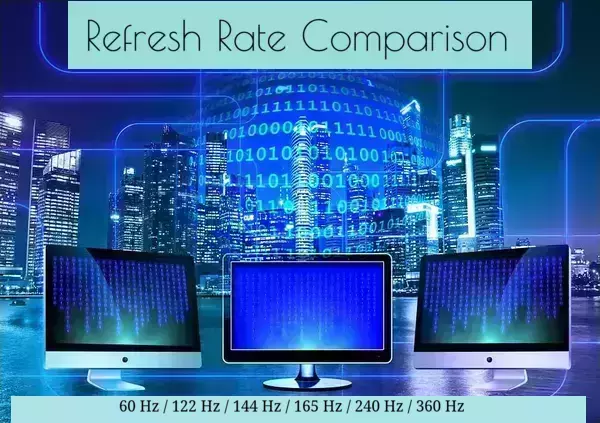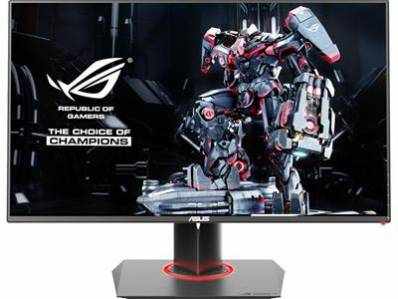Interesting history of the battle: 60Hz vs. 122Hz vs. 144Hz vs. 165Hz vs. 240Hz vs. 360Hz
Increases in the refresh rate of displays are a growing trend. Smartphones, TVs, tablets, laptops, and, of course, displays all have them. Manufacturers are constantly innovating and developing faster panels, with the most current ones reaching rates of up to 360Hz. Yet, what benefits can high refresh rates provide, and should you upgrade?
Explanation of the Difference
The refresh rate of a display is the maximum number of times an image may be updated in one second. How smoothly and vividly the motion looks depends on the visual refresh rate. Customers are used to utilizing 60Hz displays to see information since they have been the standard for a time. Yet, for some people, 60 frames per second may look slow, like a torn-apart flipbook (kineograph), the precursor to movie animation.
As was said before, increasing the number of refreshes not only improves clarity but also has a significant impact on the fluidity of motion. As can be seen in the section below, the refresh rate plays a significant role in how clear and easy to understand a video is. Also, as there is less time in between frames, there is reduced input latency since the monitor is more readily available to display your input instructions. Displays with a high refresh rate often have faster response times, resulting in a more detailed image with less blurring around moving objects. To sum up, these are things that might greatly improve the overall quality of the service provided to the customer.
Yet as you climb higher, the advantages diminish. As can be seen in the chart, the time between frames decreases considerably from 60Hz to 144Hz, by 9.73ms, but only by 2.77ms from 144Hz to 240Hz and 1.39ms from 240Hz to 360Hz. Despite the fact that everyone perceives motion and input latency differently, the vast majority of people will likely have trouble seeing any difference over 240Hz. If you’re not a competitive or esports player, it’s advisable to spend the extra money on other things.
| Refresh rate | Frames per Sec |
|---|---|
| 60Hz | 16.67ms |
| 144Hz | 6.94ms |
| 240Hz | 4.17ms |
| 360Hz | 2.78ms |
Frames Per Second and Refresh Rates
It is easy to fall into the trap of thinking that suddenly everything on your computer will seem to be of higher quality if you upgrade to a monitor that has a faster refresh rate and is able to display motion with more fluidity. Yet this isn’t always the case.
Keep in mind that the image on your display may only be changed at the rate specified by the refresh rate, which is the maximum allowed rate. But, a program’s frame rate determines whether or not it sends data to your display at that rate. The frame rate is a statistic that indicates the number of video frames that are sent to your display in one second.
If you want to get the most out of a display that has a higher refresh rate, the data that is sent from your computer to the display will need to be done at a much faster rate. The vast majority of applications, such as those used for playing back videos and those used for productivity, are unaffected by an overly fast refresh rate.
Which Option Should You Choose?
There is no such thing as the appropriate or inappropriate refresh rate. The answer to that question is wholly contingent on the manner in which you utilize it, the goals you want to achieve, and the level of tolerance you have. The majority of users are not only used to a refresh rate of 60Hz for their day-to-day activities, but many also find that it is fairly pleasant while playing video games at that pace.
60HZ – Universal
Best for: PCs with integrated graphics, productivity, media consumption, and mixed usage.
Displays on computers often have a refresh rate of sixty hertz, or 60 Hz. The vast majority of desktop programs may be used at this refresh rate without the need of a specialist graphics card. It is the industry standard for use in ordinary office settings or other environments where the smoothness of motion is not as important. You are able to play games on a display that has a refresh rate of 60 hertz (Hz), but depending on the game and the resolution you play it at, you may require a little bit more graphics processing power to achieve a gaming experience that is relatively smooth. This is because any drop in frame rate is much more noticeable in this range.
144HZ – Mixed Use, Rising Popularity
Best for: Multimedia, Gaming, and Mixed Use.
Even though there are panels that are capable of refreshing at even faster rates, the most common refresh rate of 144 hertz is still the one that manufacturers choose to use. The experience is far more fluid and responsive than that offered by a monitor with a 60Hz refresh rate, which can be used for either gaming or regular desktop use. A 144Hz monitor has the capability of displaying content that has a frame rate of 24Hz without the need to convert the frame rate, making it an excellent choice for watching movies and other forms of media. If you want to play games at 1080p or 1440p, you’ll need a computer that’s in the middle of the spectrum, but if you want to play games at 4k, you’ll need a graphics card that’s on the high end.
240HZ – For Sophisticated Gamers
Best for: gaming.
Displays with a refresh rate of 240 hertz are still relatively new to the market, but they are gradually becoming more popular, particularly among enthusiasts and serious gamers. Both 1080p and 1440p resolutions are available. Depending on the resolution, these screens can only be used to their full potential with a graphics card that falls between between a mid-range and a high-end model.
360HZ – Too Much. But What About Tomorrow?
Best for: gaming
Those that compete in competitive esports will benefit the most from this.
Displays with a refresh rate of 360 hertz have just lately gained widespread use. At the moment, they are only available in 1080p resolution; however, we hope that higher resolution variations will become available in the near future. They are ideal for gamers that compete professionally in esports and need the least degree of input lag. They also need strong computers to create such a high frame rate.
60 Hz vs. 144 Hz
To get things rolling, let’s take a look at the two most common refresh rates side by side. Most people may notice the difference between 60 Hz and 144 Hz quite quickly while watching fast-paced media or playing video games.
The 144 Hz display is much smoother and clearer in motion than the 60 Hz screen, with significantly less blur between each frame. When motion blur is reduced, the picture sharpens, enabling you to perceive much more detail in fast-paced media.
With something like text, this is especially true. If you’re using a 60 Hz monitor, you may not realize that moving the window would cause the text inside it to blur or become illegible, but with the higher refresh rate display, this won’t be an issue. Furthermore, the faster refresh rate display makes the experience of scrolling or resizing windows much more seamless.
If you’re interested in the 60 Hz vs. 120 Hz dispute, use all of the above reasons, but tone them down a little.
144 Hz vs. 240 Hz
The heavyweight bout between 144 Hz and 240 Hz follows. We’ve shown that the difference between 60 Hz and 144 Hz is significant enough that almost all users will see it right away. While there is a large theoretical difference between 144 Hz and 240 Hz, in practice the differences are much less.
There is undoubtedly a threshold of diminishing returns when it comes to frame rates, and the 240 Hz display may be approaching it. Please don’t get the wrong idea; in circumstances with lots of fast motion, the faster refresh rate does make a big difference.
The difference between 60 Hz and 144 Hz, however, is substantially less. For the time being, 240 Hz seems to be reserved for those who are willing to spend more to get the finest. You’ll need a powerful gaming PC to drive that many frames per second from a panel with that kind of refresh rate.
120 Hz vs. 144 Hz
The next item we wanted to cover is the two frame rates that are most closely related to one another, 120 Hz and 144 Hz. Because to their similarity, many people have problems selecting which of these two frame rates would be better for their needs.
These two refresh rates are somewhat close to one another, although they are very different from one another. 144 Hz monitors feature less motion blur and a more fluid appearance than 120 Hz displays. The majority of today’s 120 Hz displays are intended for use with higher resolutions or have an overclocking capability that allows them to take use of the 144 Hz refresh rate. In actuality, 120 Hz is becoming less prevalent.
The answer to the question, “Is a 144 Hz monitor worth it?” is unquestionably yes. The 144 Hz option’s better motion and more modern feature set will more than make up for the little price premium.



![Best 27 inch 144hz Gaming Monitors Reviewed [year]](https://whattdw.com/wp-content/uploads/2022/04/80-26-330x140.webp)




Guys, in short, if you’re a gamers, I’d argue that you would see a higher, more apparent gain from switching to a high-refresh rate display than you would in updating to 4K — as doing both can get extraordinarily expensive and taxing on your hardware. 120Hz or 144Hz display screens make for smoother, tear-free gaming with less input lag.